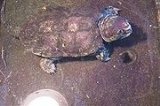
Big-headed Turtle
Encyclopedia
The big-headed turtle is a species of turtle
in the family Platysternidae.
placed on occasion in "Kinosternoidea
", it was later moved to the Emydidae
. With the Geoemydidae
being split off from these, it seems wisest to reinstate, at least for the time being, the Platysternidae. This, as well as the subfamily and the genus
Platysternon, are monotypic
.
and snail
eater.
The big-headed turtle is readily consumed in Asia and is frequently a market item. Hunters capture them on lines with baited straight pins. As such, this species is rapidly disappearing in the wild.
In addition two other subspecies Platysternon megacephalum tristernalis(1984) and Platysternon megacephalum vogeli(1969) have been given but may be invalid.
Turtle
Turtles are reptiles of the order Testudines , characterised by a special bony or cartilaginous shell developed from their ribs that acts as a shield...
in the family Platysternidae.
Background
Previously considered a distinct familyFamily (biology)
In biological classification, family is* a taxonomic rank. Other well-known ranks are life, domain, kingdom, phylum, class, order, genus, and species, with family fitting between order and genus. As for the other well-known ranks, there is the option of an immediately lower rank, indicated by the...
placed on occasion in "Kinosternoidea
Kinosternoidea
Kinosternoidea is a superfamily of aquatic turtles, which included two families: Dermatemydidae, and Kinosternidae.These are nowadays usually considered independent families of the Trionychia, among which they represent very plesiomorphic members which share a few peculiarly advanced traits...
", it was later moved to the Emydidae
Emydidae
Emydidae, commonly called the pond turtles or marsh turtles, is a family of turtles. Previously, several species of Asian box turtle were classified in the family. However, revised taxonomy has separated them to a different family. Now, Emydidae, with the exception of two species of pond turtle,...
. With the Geoemydidae
Geoemydidae
Geoemydidae is the largest and most diverse family in the order Testudines with about 70 species. It includes the Eurasian pond and river turtles and Neotropical wood turtles.-Characteristics:...
being split off from these, it seems wisest to reinstate, at least for the time being, the Platysternidae. This, as well as the subfamily and the genus
Genus
In biology, a genus is a low-level taxonomic rank used in the biological classification of living and fossil organisms, which is an example of definition by genus and differentia...
Platysternon, are monotypic
Monotypic
In biology, a monotypic taxon is a taxonomic group with only one biological type. The term's usage differs slightly between botany and zoology. The term monotypic has a separate use in conservation biology, monotypic habitat, regarding species habitat conversion eliminating biodiversity and...
.
Behaviour
In addition to a very large head, the big headed turtle is known to readily climb trees near rivers and fast streams. Kirkpatrick (1995) also mentions that Platysternon uses its beak to climb. He also mentions when swimming, this species often arcs its tail in the manner of a scorpion. The big headed turtle cannot pull its head in its shell. That being the case, Platysternon will not hesitate to use its powerful jaws to defend itself. It is a fishFish
Fish are a paraphyletic group of organisms that consist of all gill-bearing aquatic vertebrate animals that lack limbs with digits. Included in this definition are the living hagfish, lampreys, and cartilaginous and bony fish, as well as various extinct related groups...
and snail
Snail
Snail is a common name applied to most of the members of the molluscan class Gastropoda that have coiled shells in the adult stage. When the word is used in its most general sense, it includes sea snails, land snails and freshwater snails. The word snail without any qualifier is however more often...
eater.
The big-headed turtle is readily consumed in Asia and is frequently a market item. Hunters capture them on lines with baited straight pins. As such, this species is rapidly disappearing in the wild.
Subspecies
- Platysternon megacephalum megacephalum, China, 1831
- Platysternon megacephalum peguense, Myanmar and Thailand, 1870
- Platysternon megacephalum shiui, Cambodia, Laos and Vietnam, 1987
In addition two other subspecies Platysternon megacephalum tristernalis(1984) and Platysternon megacephalum vogeli(1969) have been given but may be invalid.
External links
- Big-Headed Turtle (Platysternidae
- (Chinese) Bigheaded
- (Spanish) Platysternon megacephalum

